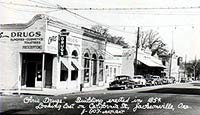| Preservation | |
| Rehabilitation 1 | |
| Rehabilitation 2 | |
| Restoration | |
| Reconstruction |






| Then & Now. The rapid growth and decline of Jacksonville combined to preserve the late 19th century buildings, village scale, and spatial relationships virtually unchanged into the 1960s. Today it is a National Historic Landmark District. |
 |
  
|
|
Community History
Early Jacksonville’s rapid development… Early in 1852, seven years prior to statehood, gold was discovered in the hills near present day Jacksonville in southwestern Oregon. Miners flocked to the Rogue Valley to seek their fortune. Within months, thousands were scouring the hills hoping to stake a claim. A thriving mining camp emerged along the gold-lined creek beds and, before long, the bustling camp was transformed into the town named "Jacksonville.” Makeshift shops, supply stores, a bank and other businesses suddenly began to appear on the scene. By January of 1853, when it became the county seat of the newly created Jackson County, Jacksonville had a population of 900. In the same year, a disastrous fire consumed most of the wood-framed commercial core, but because the town was at the height of its prosperity, it was re-built immediately, this time largely in brick.
and rapid decline… Ironically, the late 1870s largely exhausted the ore deposits, and when the main north-south railroad line bypassed the community in 1884, Jacksonville went into decline. To counter the image of impending economic doom, a few wealthy merchants built grand mansions and the new Jackson County Courthouse was completed in 1884. By the 1890's agriculture had replaced mining as the main industry in the Valley. A privately owned railroad spur ran to Jacksonville until 1927, when the County seat was moved to Medford. The rapid growth and decline of Jacksonville combined to preserve the late 19th century buildings, village scale, and spatial relationships virtually unchanged into the 1960s.
More recently… In 1962, a proposal to route the new Highway 238 through the town of Jacksonville galvanized its residents into action. The opponents of the highway project were successful in averting that disaster, but also realized that their efforts would need to continue in order to preserve the remarkable collection of properties in its setting of wooded hills. In 1967 the core of the town was designated a National Historic Landmark, and in 1977, a larger formal boundary—that included the supporting residential neighborhoods—was adopted by the National Landmark Advisory Board.
---------------------------------